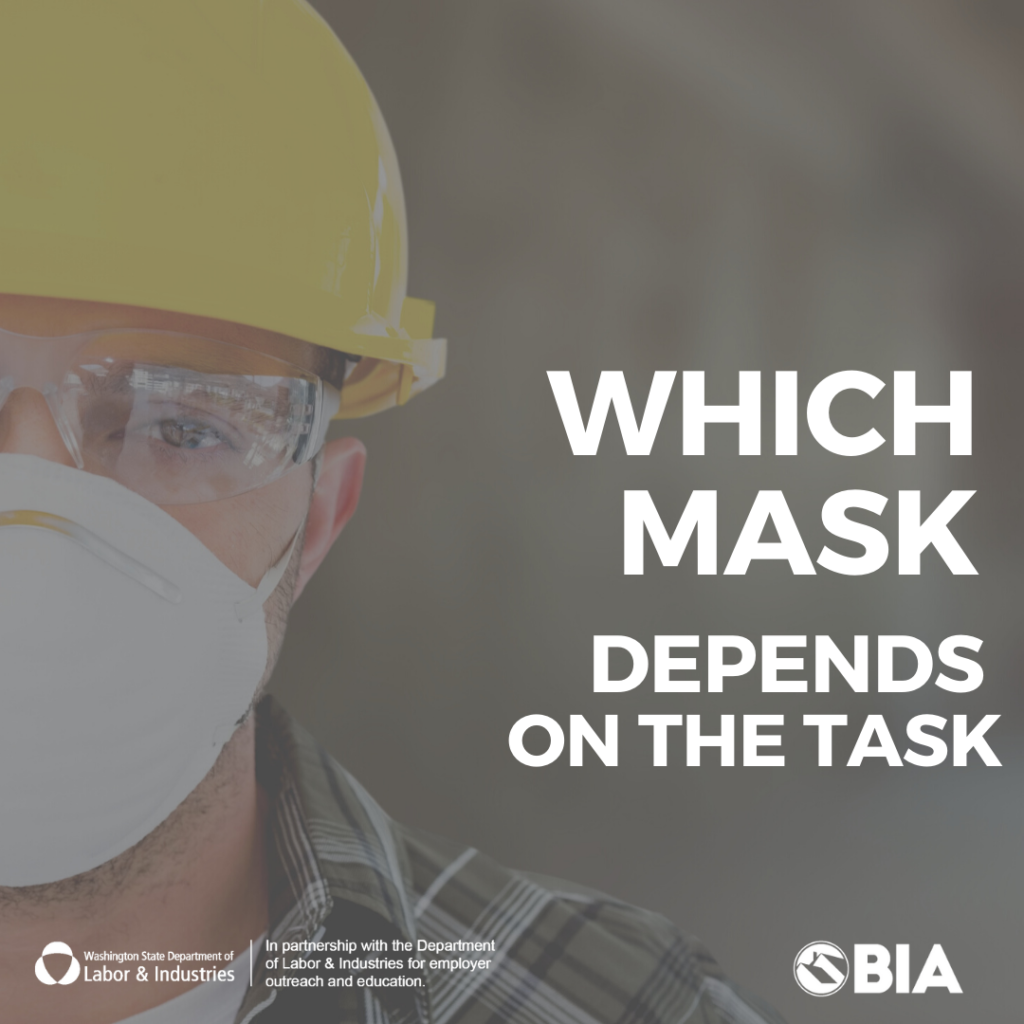Which Mask for Which Task?
 Face coverings and masks do not replace social distancing. In fact, when used in combination these are very useful strategies for reducing the likelihood of spreading the COVID-19 virus. In addition to masking up and staying 6+ feet away from others, remind your workers to always practice frequent hand washing and frequent cleaning/disinfecting of commonly touched surfaces and tools.
Face coverings and masks do not replace social distancing. In fact, when used in combination these are very useful strategies for reducing the likelihood of spreading the COVID-19 virus. In addition to masking up and staying 6+ feet away from others, remind your workers to always practice frequent hand washing and frequent cleaning/disinfecting of commonly touched surfaces and tools.
We’ve received some questions about what masks are appropriate for specific tasks. See below risk categories established by Labor and Industries’ and the Governor’s Office to understand the mask needed for assessed risk.
NEGLIGIBLE RISK
Employees working alone or driving by themselves are not required to wear a cloth face covering because the risk for transmission is negligible (very low). “Alone” means the employee is isolated from others and has little or no expectation of in-person interactions. If someone working alone has to pass another person once or twice a day, they should stay at least six feet away and wear a cloth face mask to maintain negligible risk.
Example of Negligible Risk Tasks in Construction: Small landscaping crews of three or four workers who drive separately and work alone outdoors all day OR an equipment operator isolated inside an enclosed cab.
LOW-RISK
A reusable cloth face covering is required when risk for transmission is considered low. This could be when employees work around or travel with others and stay at least six feet apart, except for briefly passing by others several times a day.
Example of Low-Risk Tasks in Construction: Subcontractors working on different phases of building a home (around others but six feet away). For instance, a plumber can be installing fixtures in a bathroom and a HVAC technician can be in the attic installing a heating and cooling system.
MEDIUM RISK
Masks are required when risk for transmission is medium. Appropriate masks include disposable dust masks used for hobbies, but not approved by the National Institute for Occupational Safety and Health (NIOSH); surgical-style masks not approved by the FDA; and masks such as KN90s or KN95s approved in other countries.
Risk for transmission is generally considered medium when workers stay at least six feet away from others except for several times throughout the day when the six-foot distance is broken for several minutes and prevention measures such as physical barriers aren’t feasible.
When employees are in vehicles, it’s considered a medium risk for up to one hour per trip if:
- There are no more than two people per compact car.
- There are no more than four in larger sedans or work trucks with two rows of seats.
- There are no more than seven in passenger vans depending on capacity.
AND
- Occupants stay at least three feet apart.
- Mechanical and natural ventilation is optimized (e.g., fresh air from vehicle system and/or open windows).
Example of Medium Risk Tasks in Construction: Crews of workers being transported to a job site.
HIGH-RISK
Risk for transmission is considered high when employees work or travel within three feet of others for more than 10 minutes an hour many times a day, and other prevention measures aren’t feasible.
Respirators are required when risk for transmission is high. Respirators for high-risk activities must be approved by the National Institute for Occupational Safety and Health (NIOSH) or by an equivalent approval body from outside the United States.
Examples include: elastomeric (rubber-like) half- or full facepiece respirators with cartridges, tight or loose-fitting powered air-purifying respirators (PAPRs) with particulate cartridges, and filtering facepiece N-, R-, or P-95s to 100s (when supplies allow).
Additionally, employers must follow requirements to ensure workers receive a medical evaluation, fit test, and training; and practice maintenance, storage, and other necessary provisions as required by the Respirators rule in Chapter 296-842 WAC. If employees use an N95 or other tight-fitting respirator, they must be clean shaven so the respirator can form a reliably tight face seal. PAPRs with loose-fitting hoods do not require fit testing and may be an alternative for bearded workers.
Risk is also considered high when workers:
- Clean and sanitize areas recently occupied by someone with known COVID-19 illness.
- Perform procedures that aerosolize saliva, mucous, or secretions from eyes; or that cause increased or forced breathing, coughs, sneezes, or yawning.
Workers must also wear goggles or face shields to protect their eyes during face-to-face interactions when not using full-facepiece respirator styles.
Example of High-Risk Tasks in Construction: Work crews in confined spaces and those working on projects in healthcare facilities, long-term care facilities, and nursing home facilities.
EXTREMELY HIGH-RISK
Transmission risk is extremely high when workers have direct contact with another person’s mouth, nose, or eyes, even if they appear to be healthy or asymptomatic.
When risk for transmission is extremely high, construction activity should seize until risk can be minimized.
Example of Extremely High-Risk Tasks in Construction: Workers placed on projects in healthcare facilities, long-term care facilities, and nursing home facilities.
Acceptable Mask Attributes:
- A properly worn mask completely covers the nose and mouth.
- Cloth masks should be made with two or more layers of a breathable fabric that is tightly woven (i.e., fabrics that do not let light pass through when held up to a light source).
- Mask should be secured to the head with ties, ear loops, or elastic bands that go behind the head. If gaiters are worn, they should have two layers of fabric or be folded to make two layers.
- Mask should fit snugly but comfortably against the side of the face.
- Mask should be a solid piece of material without slits, exhalation valves, or punctures.
The Following Mask Attributes are Also Acceptable if Masks Meet the Requirements Above:
- Masks can be either manufactured or homemade.
- Masks can be reusable or disposable.
- Masks can have inner filter pockets.
- Clear masks or cloth masks with a clear plastic panel may be used to facilitate communication with people who are hearing impaired or others who need to see a speaker’s mouth to understand speech.
- Medical masks and N-95 respirators fulfill the requirements, as well.
The Following Do Not Fulfill the Requirements of Acceptable Masks:
- Masks worn in a way that does not cover both the mouth and nose.
- Face shields or goggles (face shields or goggles may be worn to supplement a mask that meets above required attributes).
- Scarves, ski masks, balaclavas, or bandannas.
- Shirt or sweater collars (e.g., turtleneck collars) pulled up over the mouth and nose.
- Masks made from loosely woven fabric or that are knitted, i.e., fabrics that let light pass through.
- Masks made from materials that are hard to breathe through (such as vinyl, plastic or leather).
- Masks containing slits, exhalation valves, or punctures.
- Masks that do not fit properly (large gaps, too loose or too tight).’
A SPECIAL NOTE ABOUT FACE SHIELDS AND BANDANAS
Both face coverings are not a substitute for cloth face coverings because both allow particles exhaled from the wearer to freely move around the edges of the shield and into the open air for others to breathe in. Face shields in particular can be worn in combination with cloth face coverings but cannot be used in lieu of a mask.
MEDICAL ISSUES/DISABILITIES AND MASKS
For some workers, medical issues or disabilities make face coverings unsafe to wear. To be considered exempt from face-covering requirements, employees must provide their employer with an accommodation statement from their health care provider. The statement must specify that the employee should not wear a face covering because of a health condition or disability. Employers with workers who are unable to wear masks must take alternative steps to prevent the spread of the virus.
